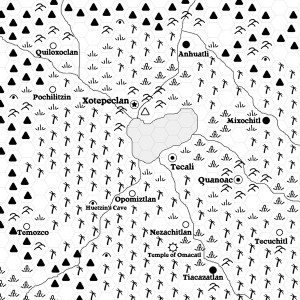Much has been discussed about the inhabitants, both human and otherwise, of Tlactoztlan. But so far, little has been revealed of its nature. Below are some verbal sketches of the three major Tlactozotl cities as well as an indication of things that are frequently seen in those cities.
The current map of Tlactoztlan is reproduced here for reference. Click on it for a larger version.
Xotepeclan
The Capital city of Tlactoztlan, Xotepeclan is a teeming metropolis at the foot of Cuhtlipocapetl, a smoldering but dormant volcano. Temples and royal palaces dot the skyline of Xotepeclan, with multiple markets scattered throughout the city.
Common sights within Xotepeclan include:
- A royal procession featuring King Cuhuitlazcaltiacapan
- A royal procession featuring a lesser noble
- Eagle Knights en route to an audience with the king
- Texotli traveling intently from one temple to another
- Merchants haggling in the market, or offering their wares to passersby
- Coztli patrolling the city, on guard for criminals
- Commoners bringing their produce to market
- Izatacli relaxing by a fountain, discussing the nature of the universe
- Jaguar Warriors recruiting Coztli to join their ranks
- A group of performers from the house of song and dance
- Servants of Nezatl Xomec, up to no good
Tecali
Called the City of Temples, Tecali is the spiritual capital of Tlactoztlan. Countless temples to the innumerable Tlactozotl gods rise along the shores of Lake Xiachitlatl, the tallest of which afford a view of Xotepeclan to the northwest. Nearly as large as the Capital itself, Tecali is a bustling center of trade, knowledge, and, occasionally, danger.
Common sights within Tecali include:
- The Great Tlatoani, high priest of Huitzilopochtli, leading a sacrifice ceremony at the great temple
- Priestesses of Xochiquetzal blessing young lovers with flower garlands
- Priests of Chicomexochtli overseeing a group of painters working on a codex
- Priests of Ixtlilton tending to the sick
- Priests of Itzlacoliuhque receiving shipments of obsidian from traveling merchants
- Priests of Tlaloc listening to the entreaties of famers in need of rain
- A group of traveling merchants waiting to be blessed by priests of Yacatecuhtli
- Coztli nervously standing guard outside the temple of Xipetotec
- A street festival with costumed dancers and poetry recitals
- A group of slaves being lead to a temple where they will be sacrificed to please the gods
Quanoac
Nestled within the hills that separate the northern and southern jungles of Tlactoztlan, Quanoac is renown as the center of Tlactozotl artistry and commerce. Here, with easy access to natural resources and precious metals, artisans from across the lost valley set up their workshops and storefronts, selling to traveling merchants, minor nobles, and free commoners alike.
Common sights within Quanoac include:
- A group of merchants engaged in a bidding war over a particularly spectacular work
- Miners delivering cartloads of ore and semi-precious stones to the largest artisan houses
- Women dyeing fabrics in an alley behind a shop
- Children playing “the bartering game” in a public square
- Young couples strolling through the city, dressed in fine new clothes for their weddings
- Toothless beggars and street urchins begging for alms
- Coztli collecting taxes from a newly arrived traveling merchant
- Izatacli in deep discussion with artisans regarding talismans they need created
- Commoners being whipped for purchasing or wearing clothing adorned with feathers


